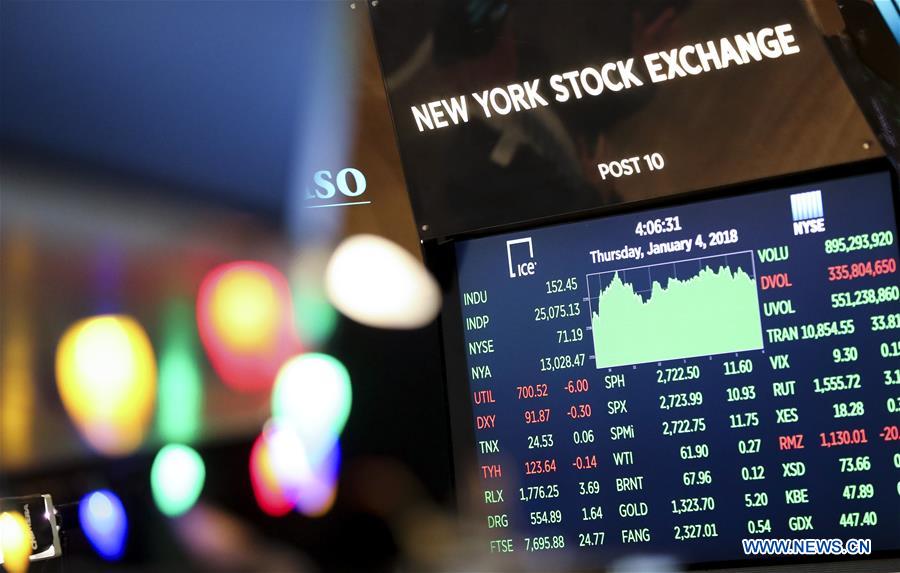
Market indexes are seen on a screen at the New York Stock Exchange in New York, the United States, on Jan. 4, 2018. U.S. stocks closed higher on Thursday, with the Dow Jones industrial average breaking above 25,000 for the first time, as jobs data from the country came out positive. At the close, the Dow Jones Industrial Average rose 152.45 points, or 0.61 percent, to 25,075.13. (Xinhua/Wang Ying)
NEW YORK, Jan. 4 (Xinhua) -- The Dow Jones Industrial Average ended above the psychologically significant 25,000 milestone for the first time ever on Thursday, 35 calendar days after hitting 24,000 points, following the release of strong employment data.
The U.S. private sector added 250,000 jobs in December, well above the market consensus of 190,000, according to the National Employment Report released by ADP Research Institute on Thursday.
Investor euphoria was ignited by the stronger-than-expected jobs data, as the ADP figure is widely seen as a pre-indicator for the non-farm payrolls report due on Friday.
All three major indexes set new closing records on Thursday. The Nasdaq Composite Index gained 12.38 points, or 0.18 percent, to 7,077.91. The S&P 500 added 10.93 points, or 0.40 percent, to 2,723.99. The Dow Jones Industrial Average rose 152.45 points, or 0.61 percent, to 25,075.13.
This is one of the fastest 1,000-point move in Dow's history. It also took the 30-stock index 35 days to rise from 20,000 to 21,000 last year.
Wall Street kicked off 2018 on a high note, with the Nasdaq Composite Index closing above the big round number of 7,000 points on the first trading day of the year. On Wednesday, the tech-heavy index also completed its best two-day start to a year since 2006 and all three indices posted historical highs.
"Positive global economic releases have propelled equity markets higher thus far in 2018 just as they did in 2017," Brendan Ahern, chief investment officer of the U.S. Krane Funds Advisors, told Xinhua on Thursday.
U.S. stocks advanced exponentially in 2017, with the Dow, the S&P 500 and the Nasdaq surging 19.4 percent, 25.1 percent and 28.2 percent, respectively. All three major indices witnessed their best annual gains since 2013.
"U.S. equity markets have risen due to the country's positive payrolls and manufacturing data in addition to benefits from corporate and individual tax reform," said Ahern.
However, some investors started wondering how much longer U.S. stocks could rally and whether the equities had higher-than-normal risks.
For 2018, Morgan Stanley expected much narrower performance for U.S. equities as markets begin to contemplate the peak rate of change on growth and deteriorating financial conditions. The investment bank also expected more volatility and bigger drawdowns.
But Ahern said concerns of higher U.S. interest rates, which could be a headwind for equities and their high valuations, have subsided for the time being as witnessed by the U.S. dollar's continued weakness.
The dollar index, which measures the greenback against six major peers, was down 0.29 percent at 91.899 in late trading on Thursday.
"Investors appear to have discounted the probability of the Federal Reserve delivering multiple interest rate hikes in 2018 which makes U.S. equities appear attractive to U.S. fixed income investments," he said.
Fed officials were divided over the pace of rate hikes in 2018, according to the minutes of the Fed's latest monetary policy meeting released on Wednesday.
"Most participants reiterated their support for continuing a gradual approach to raising the target range, noting that this approach helped to balance risks to the outlook for economic activity and inflation," said the minutes of the Fed's December meeting.
Fed officials' medium forecast for the benchmark interest rate signaled that there were three more rate hikes in 2018. Market analysts and financial institutions had similar projections on the pace of interest rate hikes.
In other economic news, in the week ending Dec. 30, the advance figure for seasonally adjusted initial claims was 250,000, an increase of 3,000 from the previous week's revised level, the U.S. Labor Department said Thursday.
The four-week moving average was 241,750, an increase of 3,500 from the previous week's revised average.
The seasonally adjusted final IHS Markit U.S. Services Business Activity Index registered 53.7 in December, down from 54.5 in November but beating market estimates of 52.4.















